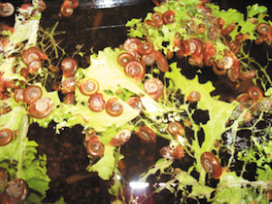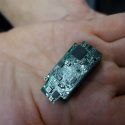‘Ninja parasites’ elude immune response through molecular mimicry
In feudal-age Japan, cunning, unorthodox mercenaries known as ninjas were notorious for using disguise, deception, and stealth to infiltrate enemy fortifications. In the world of modern parasites, certain organisms — dubbed “ninja parasites” by Professor Timothy Yoshino — use similar tactics, in a biological and chemical sense, to trick their way past the immune systems of their hosts.

Yoshino
Yoshino, professor of parasitology at the University of Wisconsin–Madison School of Veterinary Medicine, focuses his research on a specific trematode, the blood-fluke known as Schistosoma mansoni. This small, thin white worm can infect humans and eventually cause a chronic illness known as intestinal schistosomiasis. This condition affects more than 200 million people across the globe, and the World Health Organization considers it to be the second-most socioeconomically devastating parasitic disease, next to malaria.
Schistosomiasis is a common infection in places with high poverty rates where people often engage in aquatic activities. It can be found in 74 countries, primarily in the tropics of Asia, South America and the Caribbean, and Sub-Saharan Africa. While the disease has a low mortality rate, it can cause damage to internal organs and other complications that sap peoples’ strength and vitality, thus perpetuating the cycle of poverty in these areas. In addition, it stunts growth and cognitive development in children.
However, before S. mansoni can infect humans, it must first undergo several stages of development while occupying an intermediate host — in this case, snails, which are the focal point of Yoshino’s research. Shortly after this parasite’s eggs are immersed in water, a miracidium (an early-stage larva) hatches and swims until it finds a snail to infect. Yoshino’s work suggests that the larva sneaks past the snail’s defenses through a ninja-like tactic called molecular mimicry.
“A classic example of mimicry in nature is the viceroy butterfly,” says Yoshino. “Viceroys are tasty to predators, but monarch butterflies are poisonous to them, so the viceroy has evolved to look like the monarch as a way to protect itself. But in the case of S. mansoni, it seems to be disguising itself — posing chemically as part of the snail itself to avoid the host’s immune system response.”
A snail’s immune system is composed of molecules called lectins and lectin-like proteins that are presumably involved in the recognition of certain carbohydrates, or sugars, in parasites. These sugars are chemically linked to glycoproteins, which are expressed at the larval surface or are spewed out by the parasite while it is transforming into a sporocyst, the next larval stage.

In his research, Yoshino used a species of snails known as B. glabrata, which are freshwater intermediate hosts of S. mansoni.
“The evidence suggests that the lectins recognize foreign carbohydrates and trigger an immune response,” says Yoshino. “But some sugars in these parasites already occur naturally in the snails as well.”
And this is a key part of Yoshino’s work, which examines the differences between two strains of snails — one that is susceptible to S. mansoni and one that is resistant. The susceptible snails let the parasite develop while the resistant snails kill it within hours. Yoshino discovered that carbohydrates found in the parasites also are found in the snails, and they occur in higher levels in the susceptible strain. All of this represents strong evidence for molecular mimicry.
“If lectins are indeed involved in recognition, and if these sugars they recognize are part of the snail’s chemical repertoire, it is possible that the parasite is mimicking them, therefore avoiding recognition,” says Yoshino. “It raises questions about how the host and parasite may have co-evolved in sort of an arms race.”
The schistosomiasis cycle can be difficult to break. Although a very effective drug is available, it does not provide immunity, and people can be infected again within a year of taking it. As a result, providing a continuous supply of drugs sufficient to eliminate the worm in all hosts over a number of years can prove challenging. In addition, new evidence suggests that parasites are developing resistance to this drug. This is why Yoshino hopes his work will lead to other solutions.
“By manipulating expression of genes associated with resistance, perhaps we will be able to genetically manipulate susceptible snails so their progeny become resistant,” Yoshino says.
Another option may be to determine the carbohydrates in parasites that serve as primary reactants of lectins in resistant snails and induce their expression in susceptible snails. However, both of these approaches would require the identification of lectins, and the specific sugars they recognize, that are important to parasite resistance in snails — the subject of Yoshino’s continued research.
Yoshino has published findings stemming from his work, which is supported by the National Institutes of Health, in recent issues of Experimental Parasitology and PLOS Neglected Tropical Diseases.
—Nik Hawkins
Tags: disease, research, veterinary medicine



